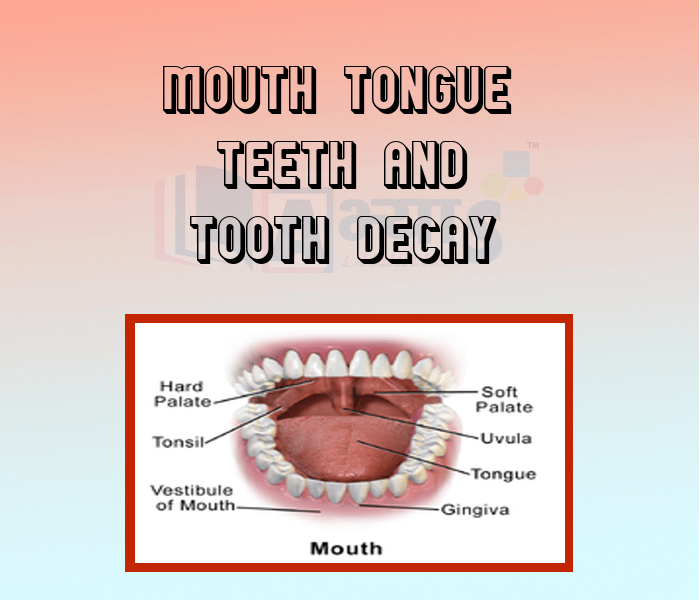Mouth Tongue Teeth and Tooth Decay











Mouth Tongue Teeth and Tooth Decay
Mouth: Mouth consists of oral cavity, through which food is ingested. It is bounded by lips and cheeks. It contains gums, teeth, a tongue and muscles.
The tongue tastes the food and moves it to pharynx. Tongue is a highly muscular sensory organ present at floor of buccal cavity. It bears several taste buds and helps in mixing food with saliva. Teeth help in biting, cutting and chewing food. Teeth masticate the food. This makes it easier to swallow food and increases its surface area for various digestive secretions to act on.
Teeth : The four types of teeth are: incisors, canines, premolars and molars.
| Types of Teeth | Lower Jaw | Upper Jaw | Total Teeth |
| Cutting and biting teeth | 4 | 4 | 8 |
| Piercing and tearing teeth | 2 | 2 | 4 |
| Chewing and grinding teeth | 4 + 6 (Pre molar + Molar) | 4 + 6 (Pre molar + Molar) | 20 |
| Total | 32 |
(nutrition).png)
.jpg)
Which of the following are correct ? (a) The process of ingestion starts from mouth or oral cavity. (b) In human beings, teeth grow twice. The sets of teeth that grow during infancy are called milk teeth. These are also called temporary teeth. (c) Tongue is free from front and can help in mixing saliva with food, swallowing the food, taking or speaking and tasting with the help of taste buds for sweet, salt, sour and bitter food. | |||
| Right Option : B | |||
| View Explanation | |||
The process of ingestion starts from ____________________ . | |||
| Right Option : A | |||
| View Explanation | |||
Which of the following is not a good habit ? | |||
| Right Option : C | |||
| View Explanation | |||
Students / Parents Reviews [10]
It was a good experience with Abhyas Academy. I even faced problems in starting but slowly and steadily overcomed. Especially reasoning classes helped me a lot.

Cheshta
10thIt has a great methodology. Students here can get analysis to their test quickly.We can learn easily through PPTs and the testing methods are good. We know that where we have to practice

Barkha Arora
10thMy experience was very good with Abhyas academy. I am studying here from 6th class and I am satisfied by its results in my life. I improved a lot here ahead of school syllabus.

Ayan Ghosh
8thMy experience with Abhyas academy is very good. I did not think that my every subject coming here will be so strong. The main thing is that the online tests had made me learn here more things.

Hiya Gupta
8thAbout Abhyas metholodology the teachers are very nice and hardworking toward students.The Centre Head Mrs Anu Sethi is also a brilliant teacher.Abhyas has taught me how to overcome problems and has always taken my doubts and suppoeted me.

Shreya Shrivastava
8thA marvelous experience with Abhyas. I am glad to share that my ward has achieved more than enough at the Ambala ABHYAS centre. Years have passed on and more and more he has gained. May the centre flourish and develop day by day by the grace of God.

Archit Segal
7thAbhyas is a complete education Institute. Here extreme care is taken by teacher with the help of regular exam. Extra classes also conducted by the institute, if the student is weak.

Om Umang
10thBeing a parent, I saw my daughter improvement in her studies by seeing a good result in all day to day compititive exam TMO, NSO, IEO etc and as well as studies. I have got a fruitful result from my daughter.

Prisha Gupta
8thMy experience with Abhyas is very good. I have learnt many things here like vedic maths and reasoning also. Teachers here first take our doubts and then there are assignments to verify our weak points.

Shivam Rana
7thIt was good as the experience because as we had come here we had been improved in a such envirnment created here.Extra is taught which is beneficial for future.
